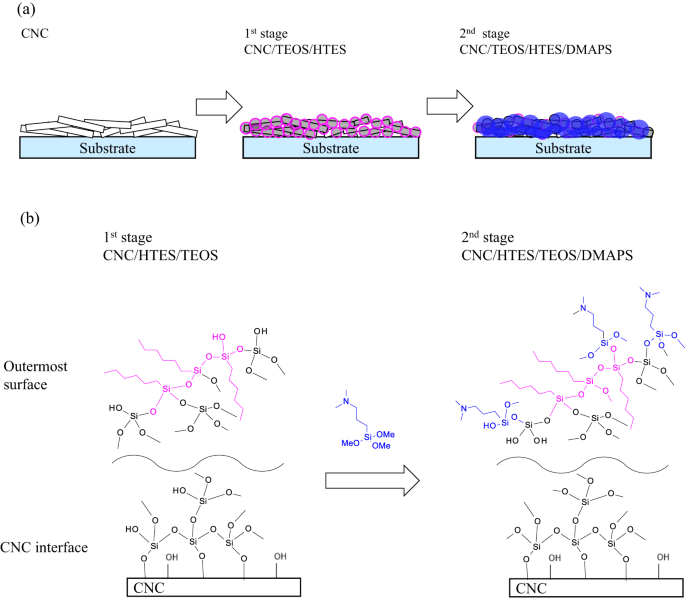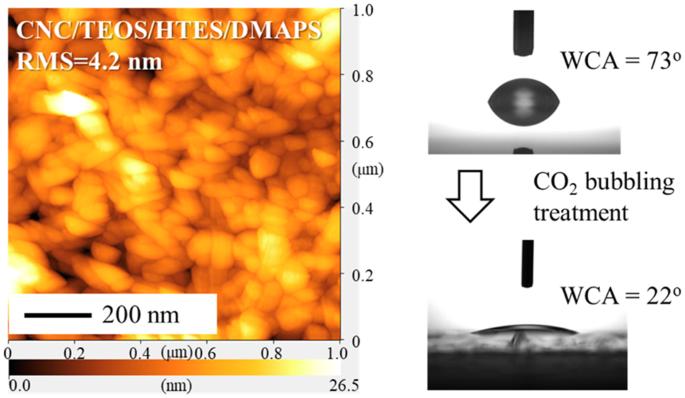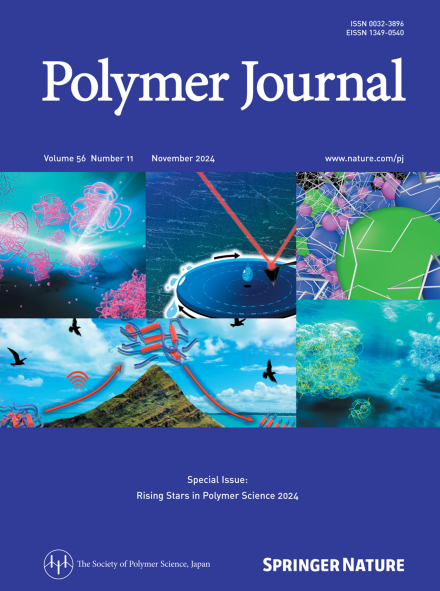通过操纵表面结构和引入叔氨基,以二氧化碳气体为触发因素控制硅烷化改性 CNC 薄膜的润湿性能
IF 2.3
4区 化学
Q3 POLYMER SCIENCE
引用次数: 0
摘要
在这里,通过引入二氧化碳气体,对纤维素纳米晶(CNC)薄膜进行了两阶段化学修饰,以实现表面润湿性控制。除了控制硅烷化改性 CNC 薄膜的表面结构外,还添加了硅烷化合物衍生的官能团,并研究了其对化学改性结果的相应影响。在第一阶段,甲基三乙氧基硅烷(MTES)和己基三乙氧基硅烷(HTES)与四乙氧基硅烷(TEOS)在碱性条件下进行缩合。在第二阶段,(3-(N,N-二甲基氨基)丙基)三甲氧基硅烷(DMAPS)产生一个氨基,通过吸附二氧化碳气体来控制表面润湿性。然后,通过旋涂法在玻璃基底上制作了硅烷化改性 CNC 薄膜。傅立叶变换红外光谱(FT-IR)、核磁共振(29Si-NMR)和 X 射线光电子能谱(XPS)检测表明,硅烷化合物已键合在 CNC 薄膜表面,并成功引入了三级氨基。原子力显微镜(AFM)分析了硅烷化改性 CNC 薄膜的表面结构,表面粗糙度计算表明均方根粗糙度(RMS)为 4.2 nm。二氧化碳气体处理前后的水接触角分别为 73o 和 22o。本文章由计算机程序翻译,如有差异,请以英文原文为准。


CO2 gas-triggered wettability control of silylation-modified CNC films by manipulating the surface structure and introducing tertiary amino groups
Here, cellulose nanocrystal (CNC) films were chemically modified in a two-stage process to realize surface wettability control through the introduction of CO2 gas. In addition to controlling the surface structure of the silylation-modified CNC film, functional groups derived from silane compounds were installed, and the corresponding effects on the resulting chemical modification were investigated. In the first stage, methyltriethoxysilane (MTES) and hexyltriethoxysilane (HTES) combined with tetraethoxysilane (TEOS) were subjected to condensation under alkaline conditions. In the second stage, (3-(N,N-dimethylamino)propyl)trimethoxysilane (DMAPS) generated an amino group to control the surface wettability by adsorption CO2 gas. Then, the silylation-modified CNC film was fabricated on a glass substrate by spin coating. Fourier transform infrared (FT-IR), nuclear magnetic resonance (29Si-NMR), and X-ray photoelectron spectroscopy (XPS) inspection indicated that the silane compounds were bonded to the CNC film surface and that tertiary amino groups were successfully introduced. The surface structure of the silylation-modified CNC film was analyzed by atomic force microscopy (AFM), and the surface roughness calculating indicated a root-mean-square roughness (RMS) of 4.2 nm. The water contact angles before and after the CO2 gas treatment were evaluated as 73o and 22o, respectively. The modification of cellulose nanocrystal film using alkyl silane and silane containing tertiary amino groups was performed in a suspension state. Control of the surface structure and functionalization by silane compounds was conducted in the two-stage process. Wettability change property of the silylation-modified CNC triggered by CO2 was demonstrated.
求助全文
通过发布文献求助,成功后即可免费获取论文全文。
去求助
来源期刊

Polymer Journal
化学-高分子科学
CiteScore
5.60
自引率
7.10%
发文量
131
审稿时长
2.5 months
期刊介绍:
Polymer Journal promotes research from all aspects of polymer science from anywhere in the world and aims to provide an integrated platform for scientific communication that assists the advancement of polymer science and related fields. The journal publishes Original Articles, Notes, Short Communications and Reviews.
Subject areas and topics of particular interest within the journal''s scope include, but are not limited to, those listed below:
Polymer synthesis and reactions
Polymer structures
Physical properties of polymers
Polymer surface and interfaces
Functional polymers
Supramolecular polymers
Self-assembled materials
Biopolymers and bio-related polymer materials
Polymer engineering.
 求助内容:
求助内容: 应助结果提醒方式:
应助结果提醒方式:


